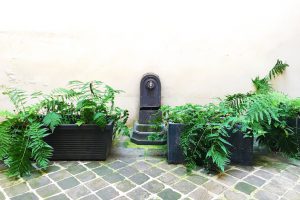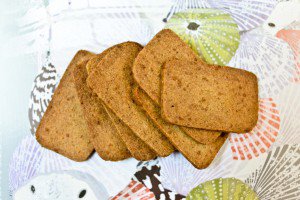As promised yesterday, when I announced the winners of the green kitchen tip contest, I have compiled a digest of the other submissions.
I want to thank you all for taking the time to share your tips. It was an exciting feeling to have all 288 of them pour into my inbox throughout the day, proving yet again how much you care about these issues, and how hard you try to minimize your impact on the environment.
I learned a lot, too, and I will work to incorporate as many of these habits as I can into my own kitchen routine. The good news is, green often equates frugal, so now is the perfect time to put them into practice.
Some of those tips may only make a small difference, one that might seem negligible in the eye of glass-half-empty people, but small differences add up, and the important thing is the mindset: once you start to consider your actions and your surroundings with environmentally-conscious spectacles, everything matters, regardless of scale.
I will add that those tips should all be taken with a grain of salt, and a whole shaker of common sense: depending on your personal situation, location, equipment, etc. the greener choice may not always be the one suggested here.
1. Buy Local and Seasonal
2. Reduce Food Waste
3. Reduce Packaging Waste
4. Reuse Packaging and Containers
5. Eat Fewer Animal Products
6. Grow Your Own
7. Compost
8. Avoid Using Disposable Paper and Plastic Products
9. Bring Your Own
10. Save Energy
11. Conserve Water
12. Use Natural Cleaning Products
13. Share
1. Buy Local and Seasonal
“Eating local foods (to avoid transportation costs), whole foods (to avoid processing costs) and organic foods (to avoid petroleum-based fertilizer usage) is a big step toward reducing our carbon footprint.” (Joanna) “Sign up to your local Community Supported Agriculture scheme. You’ll be helping small (and often organic) farmers survive, and you’ll get fresh, tasty food.” (Melanie)
2. Reduce Food Waste
Producing food, packaging it, and transporting it to points of sale consumes energy and fresh water; by not wasting food, you’re preserving those resources, too. Buy only what you need and as much , and challenge yourself to use it to the last crumb. Plan menus so you can buy the items on your list from the farmers’ market, cut down on extra trips to the store, and avoid waste.
Save vegetable and meat scraps (vegetable peelings, sad looking vegetables or parts you don’t like, meat bones) in a large resealable container in the freezer. When you have collected enough, use it to make soup or stock, which you can then freeze for later use. You can also use whatever leftover vegetables you have at the end of the week in a stir-fry, a pasta dish, or a frittata.
Freeze leftovers if there is even the smallest chance that you won’t be able to use them before they go bad. Ice cube trays work well for small amounts. Related read: Mark Bittman’s New York Times article, Freeze That Thought.
Keep your pantry well organized, and all your supplies visible: this ensures you don’t accidentally let things spoil, and you can then buy ingredients in bulk without running the risk of wasting them.
Keep only a small garbage can in the kitchen; this will encourage you to monitor and reduce the amount of waste you produce.
Find uses for every last bit: beet/radish greens and carrot tops can go into green smoothies, over-the-hill apples can be turned into applesauce and stale bread into croutons, the rind of hard cheese can flavor a soup, used green tea bags can serve to make green tea rice, bruised fruits can be added to smoothies, citrus peel can be used in baking or salads… Carrie notes that her dog loves strawberry tops and celery leaves, and Mary Ann and Katherine use the papery skin of onions to dye Easter eggs.
“Just before you go away for a few days, rummage through your fridge and window boxes. Collect all the half-used herbs, chilies, ginger, garlic, lemons, etc. and grate, chop, or zest them. Blend them (mix as you feel) with some softened butter, wrap up into sausage-shaped logs and pop into your freezer. Now when you come back you have flavoured butters to top your cooked vegetables, pasta, or grills.” (Ailbhe)
3. Reduce Packaging Waste
Buy ingredients in bulk and bring your own containers or bags to the store where you buy them.
Make your own snacks and pack them in reusable containers. Ursula suggests “invest[ing] in a few reusable fabric bags; Etsy has great options if you search under snack bags.”
Make your own spice mixes. “We have a tendency to buy everything pre-packaged and pre-made. However, there’s really no need to buy chili powder, steak rub, poultry seasoning, fajita seasoning, seasoning salt, and the like. For anyone who cooks regularly, chances are that they already have all the necessary spices in their cupboard.” (Carrie)
“Stop buying plastic wrapped cheese. Bring your own container or have them wrap it in waxed or parchment paper — if they don’t have that, ask for it, so they know you do care.” (Martina)
“Instead of using the small (and rather flimsy) plastic bags for my produce, I use organic cotton mesh bags (available online). They are very durable, so I can stock up at the farmers market, reasonably priced and washable.” (Courtney) Dana suggested making your own one string bags.
Avoid buying “pre-portioned products — individual disposable serving cups of pudding/applesauce/yogurt/juice may be handy but they are more expensive and create more waste. Get reusable containers in sizes you like and portion out of a large container.” (Pam)
4. Reuse Packaging and Containers
It is impossible to eliminate packaging and containers entirely, but what you can do is make the most of those that do enter your kitchen, finding other uses for them beyond their original purpose.
– Glass jars — inarguably the most popular of reusable containers — and take out containers can be used for food storage, leftover storage, and as pantry organizers.
– Food bags (bread bags, cereal bags, chip bags, produce bags…) can be used to store other foods or as trash/litter bags.
– Yogurt containers can be used to dispose of oil and cooking grease cleanly.
– T.R. “can only get onions in net bags, and make[s] nylon scrubbies out of them.”
– Old newspapers (not a food packaging, but handy nonetheless) can be used to “deodorize food containers (just stuff a ball in it and leave it overnight) or to line bottom of produce bins to absorb excess moisture.” (Jenn)
– Butter wrapping papers can be saved in the fridge or freezer and used to grease cake pans.
– The corks from wine bottles can “go into the planters. They keep moisture in and mischievous little pet noses/paws out.” (Elizabeth)
– Many other items can be put to creative use in endless craft projects, such as these cereal box notebooks.
5. Eat Fewer Animal Products
The production cycle of meat consumes a lot of energy and generates a considerable amount of pollution (industrial livestock production is responsible for 18% of all greenhouse gas emissions), so turning to non-animal sources of protein — for at least some of your meals, as in Mark Bittman’s vegan before six strategy — is an earth-friendly food habit to develop. And if/when you do buy meat, buy less of it, and favor local farmers that raise the animals humanely and feed them a natural diet.
Sarah adds this caveat, “While I do think it’s important to cut down on meat consumption, be careful what you replace it with. [Some] vegetarian ‘meat’ products are made from genetically engineered soy. The industrial farms these are grown on use pesticides that stay in the environment, waste energy, and deplete soil nutrients. Instead, up your intake of local, organic produce with occasional real, free-range meat!”
Be mindful of your seafood consumption, too, as explained in this past post, The Sustainable Seafood Dilemma.
6. Grow Your Own
Grow what produce and herbs you can in your garden, but also on your balcony or window sills, where you can plant rucola, leaf lettuce, and all sorts of herbs. You can also grow sprouts indoors.
As Annie sums up, “Growing plants provides habitat and food for animals large and small: bugs who seek shelter, butterflies and bees who polinate flowers. If you have a fruit tree you provide perches for song birds and nesting habitat as well as shade and protection. Food plants help absorb CO2 and produce oxygen. And, you can reduce your carbon impact by reducing the distance your food travels to get to you. If you can grow your garden plants without pesticide or chemical fertilizer, you’re also reducing the load of chemicals that go into the atmosphere, water, soil, and your body. The best part though is the wonderfully fresh and nutritious food you get to eat!”
Of course, it’s important then “not to let the produce go to waste. Roll up your sleeves and preserve them by canning and freezing (there are tons of tutorials and instructions online that are easy to follow) or simply share with neighbors and charitable food organizations!” (Tamra)
Catriona explains that, “Coffee grounds make great fertilizer for your garden: and if you’re living in a city-centre apartment, they can help your window box flourish, too! You can either sprinkle the grounds (cooled, please!) around the base of your plants (or mix into the soil if you’re creating a new window box/planter) – every time it rains or the plants are watered, nitrogen will be released into the soil, or you can add some coffee grounds to your watering can, and create instant liquid fertilizer.”
Additionally, Samantha suggest “using your egg shells and egg cartons in place of peat [or plastic] pots to start your seeds indoors. You can plant them directly in the ground or your raised bed garden, which enhances the soil also.” And Marjolaine adds, “I keep the eggshells I use for cooking, I dry, crush, and use them in my little garden or in the potted plants to add calcium to the earth instead of using bone powder.”
7. Compost
If you have a garden, start a compost heap or bin, and home-compost your organic waste (vegetable and fruit peels and cores, coffee grounds, egg shells…). These debris will decompose faster and more safely there than in a landfill, where their decomposition generates methane, a greenhouse gas. And once broken down, they will turn into natural fertilizer for your garden, thus returning the nutrients to the soil.
Those who live in an apartment can consider vermicomposting (read the New York Times story Andrew pointed me to) or Bokashi composting. And if you have no use for the fertilizer, or for that much fertilizer, you can give it away or dispose of it — in a nearby park, for instance (provided the city okays it).
Alternatively, find out if your city, or an organization in your city, collects green waste. You can keep the scraps in the freezer in between collections to avoid the development of odors.
8. Avoid Using Disposable Paper and Plastic Products
Use real napkins when you eat, and cloth rags (cut out from old t-shirts, torn sheets, etc.) instead of paper towels. When they’re dirty, Ruth “toss[es] them in a small basket under [her] sink and [does] a wash as needed.”
Use saved glass containers to keep leftover food or bring food into the office, instead of using plastic wrap or foil. And Dawn adds, “If you take your lunch to work on your bicycle like I do, and you’re worried about breakage, just wrap the glass jars in a tea towel: it protects them and you can use it for an elegant napkin at lunch!”
Unless the water from the tap is not safe to drink where you live, avoid buying and drinking bottled water, both in your house and at the restaurant. You can get a water filtering pitcher instead (make sure the cartridges can be recycled) to purify tap water, and get a reusable water bottle for when you need portable water (at the gym, at the office, when you travel).
9. Bring Your Own
Bring your own reusable silverware and plates on picnics, on camping trips, and for lunch at the office. Zazie adds, “In Taiwan, you’ll see people carrying their own chopsticks anywhere.”
Bring a real mug for tea or coffee at the office, rather than use a plastic or paper cup. And “bring your own reusable travel mug to coffee shops: not only do you save a paper cup, but most coffee shops give a free upgrade (size, flavor shot, etc) or discount.” (Lindsay)
Bring reusable shopping bags when you run errands. Keep them wherever you may need them when you go shopping: Kiwi says, “I keep a small one in my purse and work bag at all times. When I unload my groceries, I take the bags and put them by my front door immediately so that I have to pass in order to open my front door.”
“Find a store that sells eggs individually and keep your one egg carton and refill it.” (Anne)
“When buying take-out food, bring a reusable container and ask them to package the food in it.” (Fiona) And if you live in a country where restaurant portions are large and it is common practice to take one’s leftovers home, do the same when you eat out.
Related read: How green is your takeaway container?
10. Save Energy
When buying a new appliance, make sure you opt for the most energy-efficient model.
“Use [the] electric kettle to boil water rather than the stove — it’s much faster and uses less energy. I do this whenever I need boiling water — say, for pasta, vegetables etc.” (Anne)
“Make casseroles using a slow cooker (crockpot); it uses far less energy than a conventional oven.” (Annabel)
“I try not to turn on the oven unless absolutely necessary and when I do I try to bake two or three things at once.” (Kate) “I’ll throw a foil-wrapped head of garlic in to roast
or a couple or potatoes for another time.” (Becca) “In the winter, after using the oven, keep the door open to warm your house. I often put my wet dishtowels over the oven door to dry.” (Christine)
“When cooking for one or two, use a toaster oven instead of a conventional oven. The compact space requires less energy to heat.” (Marianne)
“Whenever I cook a meal, I make sure to make a double recipe. Not only do I have leftovers for an easy lunch or dinner the next day, but I also save energy because the stove doesn’t need to be turned on the next day.” (Cookin’ Canuck)
“Plan ahead of time and defrost items in the fridge instead of using the microwave.” (Caitlin)
“Use a pressure cooker for beans and stews. It cuts down on electricity usage by shortening cooking time and keeps the kitchen cooler which means you’re using less electricity if the a/c is on. Plus it means that you can get dried beans instead of canned which cuts down on packaging and other stuff from the manufacturing process.” (Kim)
“Use your hands. Leave the food processor alone; use a knife. Use a whisk, not a mixer. Let your food prep be slower, but more hands-on, and more satisfying.” (Meri)
“When cooking, remember to use your saucepan lids, when appropriate, and turn down the heat!” (Helen)
“To avoid boiling the kettle repeatedly during the day (and using lots of electricity), I boil a full kettle once in the morning and then fill up a thermos flask with hot water. Then I can make myself cups of tea or coffee throughout the day without having to boil the kettle again.” (Charlotte) “I like to make sun-brewed iced tea – saves on the energy used to heat the water, *and* it tastes better (to me, at least)!” (Tiffany)
“Don’t pre-boil pasta water. Put your pasta in the pot, fill to cover just a little over the pasta, then boil. We tried it and not only does the pasta come out fine, but you save water, some energy, and you have this fantastic thick pasta water that makes sauces creamier.” (Anna)
“Clean your refrigerator coils. They dissipate heat, so if they’re clogged with dust, your refrigerator is less efficient and uses more energy to keep itself cool. This is a big deal since refrigerators use a lot of energy — about 15% of a home’s electricity. You can clean the coils twice a year with a vacuum and/or brush.” (Anna)
“I unplug everything but the refrigerator in my kitchen when it is not being used. Microwave, mixer, coffee maker, electric can opener, etc. Around my house I also unplug lamps in areas seldom used (like the formal living room), cell phone chargers, night lights, etc.” (Libby)
“I bought an electricity measurement device and measured actual electricity use. It led to a better understanding of actual energy use. It persuaded me to use my oven less, stove and countertop appliances more.” (Rob)
11. Conserve Water
It is generally considered more water-efficient to use a (modern) dishwashing machine than to wash dishes by hand. But if a dishwasher is not an option, make sure your dishwashing technique is optimal.
When you wash salad leaves and vegetables, save the water in a bucket and use it to water your plants. Tory adds that she also “save[s] the water that passes through the tap while [she’s] waiting for it to heat up” and uses it to fill the kettle or a vase, wash vegetables, etc.
“When you steam vegetables or soak beans and lentils, don’t drain the water. Reuse the water. With the beans and lentils you can use it as cooking liquid and with the vegetables, you can use it make light broths or use in soups. This way you don’t waste water and you retain all the nutrients in the food.” (Sangeetha)
12. Use Natural Cleaning Products
Use eco-friendly cleaning products with no phosphates in them, and consider making your own, using age-old ingredients such as white vinegar, sodium bicarbonate, lemons, real soap, essential oils, etc. Carine pointed me to this excellent recipe booklet (in French).
13. Share
Share information, advice, recipes, share ingredients bought in bulk, share what extra produce your garden may yield, share CSA shares, share appliances, share rides, etc.
“I am a law student living by myself. I have other law student friends who live by themselves as well – and this semester we’ve started trading off the cooking/shopping duties. It livens up your menu, it lets us take less trips to the store, and it is helping all of us clean out our pantries for the summer!” (Kate)
“My tip is to help. For example, last Christmas I decided to get my sister shopping bags. Now that she has the “good” bags, she is all on board with reusable shopping bags and sharing it with others. I offer to help others with their recycling. Recyclables that can’t be picked up at the curbside need to be taken to a recycling center that is a ways out of town and has long lines.
Whenever I go, I spread the word and offer to take other people’s recycling in for them. Not only does it cut down on car trips, but the items for sure do not end up in the landfill and hopefully next time they will think before deciding it is just easier to toss it. I help others grow their own food and I help people set up composting systems. Some of the people I helped get started with vegetable gardening became great gardeners and now are the gardening gurus for their friends and neighbors. I think often others need more than an example, but less than a lecture. If you can figure out what is stopping them from doing the right thing (and sometimes it is just that the wrong thing is easier) and solve that problem for them, then that usually puts them on the path to do the right thing in the future.” (Kim)














